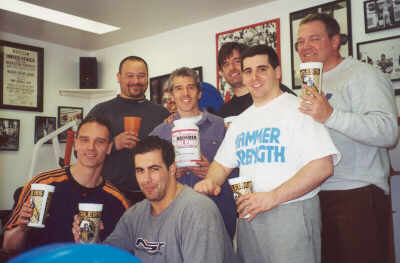Dr. Ken on Training Smarter
Dr. Ken Leistner responds...
In his distinctive way, Dave is a very important and instructive author. He speaks always from his personal perspective, never pontificates, and understands that there are numerous paths to the same goal. His "Draper Here" piece of a week ago (Another Imaginative Musclehead with Nothing Better to Do), however, was I thought, an all timer. If I had to sum it up to those who haven't read it thoroughly, I would say, "As you get older — especially as you get older — train hard but train smarter."

It's
Bomber Blend for everyone after a Saturday
workout at Dr. Ken's garage.
Front: Mike Senft, Frank Ferrara
Rear: Mark Seida, Dr. Ken, Vinny B, Vinny F, Don Herklotz
I have a reputation in the iron game for doing things intensely. As an author once wrote, "Dr. Ken represents the lunatic fringe of high intensity training." According to those who've known me for decades, it is sometimes said or implied that I represent the lunatic fringe in almost everything I do, especially in my own training. Well, as "smart" as I think I am, it's important to get hit in the head on occasion to understand that I'm not.
This certainly has been the month that "was." Four weeks ago, I separated my right shoulder, sustaining an avulsion fracture of the right coracoid process when the short head of the biceps tendon pulled off of the coracoid process (the "end" of the shoulder blade, and took a piece of bone with it). Although this occurred on a Sunday, I waited until Wednesday to have the orthopedist reduce the separation — "put the shoulder back in place — and no, it isn't done the way Mel Gibson does it in the Lethal Weapon movies).
On Thursday morning, while supervising the rehabilitation of a patient, I discovered a slight flaw in the design of a Hammer Biceps machine. Distracted by my shoulder pain, I stuck my right index finger between the machine frame and the moving cam, exactly where four bolts approximate each other. My finger was shredded, rolling the nail and skin down to the level of the tendon, up to the first knuckle. With my clotting disorder, I will just say that the degree of bleeding made for a terrible mess and the first priority was halting the blood flow.
At this point, the shoulder has full range of motion, very sIight pain in some phases of motion, and very little strength. I struggled yesterday in my first workout, a jump up from specifically doing nothing but rehabilitation exercises, to overhead press, 120 for ten reps. My finger is still wrapped daily and a mess to look at, with constant pain, swelling, and loss of sensation through much of the first third of the digit.
Last Monday, I compounded my problems. You would think that a marginally intelligent person, who at 54 years of age had a solid three weeks to consider his situation, would have seen the writing on the wall. I didn't. On Monday, the Mastiff (Neese)-made Super Yoke that I had ordered for my guys arrived, and I felt I could get my right arm back far enough with its very wide spacing to hold and walk with it.( I had not been able to squat during the first three weeks of shoulder rehab as I could not get my arm into proper position and would now make up for it.)
Instead, I steadied myself, stood upright with the Yoke, a light one, too, at 300 pounds... immediately blacked out... and hit the concrete hard. I remained a bit disoriented for the remainder of the evening as patients noted to both Kathy and me. On Tuesday, I told Kathy that I "had to give it another run." Without even looking up from her bowl of yogurt and fruit, she just mumbled, "Obviously." I was oblivious to her sarcasm.
Later in the day, I again stood beneath the Yoke, a bit gingerly this time, and cruised the approximate distance of 170 feet up the driveway and then back to the garage. I smiled, put the Yoke down, and immediately fell, throwing up as I did. I threw up, grew steadily more "headachy" over the next few hours, and then became extremely disoriented. I again met the incredulous stares of patients as I was told I could not carry on a conversation. I knew I had a headache and didn't feel "quite right" but did not realize that I was literally out of touch.
I awoke Wednesday, still foggy but aware that I did not have a stroke, as Kathy later noted she had considered as a possibility. "You can be so goofy sometimes, it was hard to tell if you were just a little bit off, or really way off." I remained disoriented, and finally realized I was disoriented late in the afternoon on Wednesday as my training partner Vinnie B. and I argued about a conversation he claimed I could not follow. It was not until Wednesday evening that I realized that I had "lost" almost two days.
*I use Bryan's Mastiff strongman equipment because it's the best made. Because I had difficulty with one piece does not make it contraindicated for anyone else. If any of the IronOnline readers are looking for strongman stuff, this is the place to get it.*
And the connection to Dave's article? Well, I've made concessions through the years after many injuries relative to my training. I haven't even tried to bench press since my last shoulder surgery of 1995. I haven't pushed for a heavy single in the overhead press either. I haven't tried any set of squats of less than 10 reps, and usually stay in the 15-20 range to keep excessive forces off of my knees since my last knee surgery which was in 1994. The wrist surgery forced me to give up most forms of curls quite a few years ago.
The list goes on so I saw myself as being very moderate, quite smart, and extremely prudent but let's face it; I'm an idiot!! Dave's article came the day after I realized I had compressed a mass of scar tissue that sits directly on my spinal chord at C5-6. Because I haven't had any difficulty or symptoms related to it since 1999, I "forgot about it." There comes a time when all of us have to evaluate what we do, carefully (stress that word) note the injuries, disabilities, and potential problem areas we have physically and then construct a program or group of movements that can be done with a relative degree of safety.
Even the safest and best designed machine is not safe for one with a specific underlying problem that the specific piece might irritate. We have to, as Dave so sagely reminded us, avoid those things that hurt, or that might hurt. The idea is to choose those things that are effective and also, as safe for us as individuals as possible.
It is not a call to lay down our arms. In fact, knowing that my potential for strength and muscular improvement is reduced with age, each workout reminds me that I have to in fact train harder than before, train harder than I think is possible, train with an intensity that perhaps I had been unable to summon previously. It's also a reminder, that while doing that, there is a real need to train smarter... while I'm trying to train harder. Hail Draper, the philosopher King!
Dr. Ken
Click here for Dr. Ken's talk on training in the 1960s.
Click here for more of Dave's columns
Click here to see more of Dr. Ken in our forum

